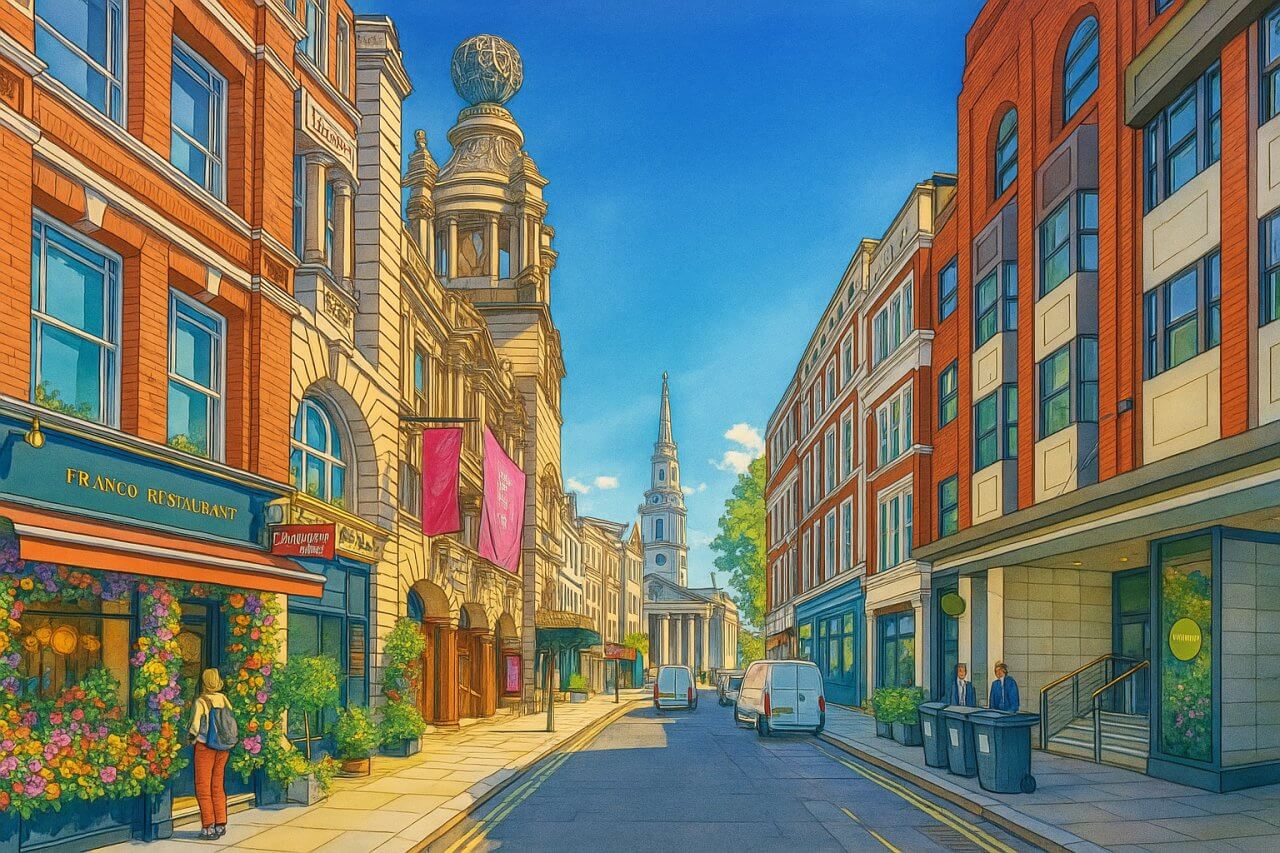
St Martin's Lane, London
St Martin's Lane is a historic and lively street in the City of Westminster, right in the heart of the West End of London. This slender one-way thoroughfare channels southbound traffic from a busy six-way intersection at the northern end down to its southern terminus at William IV Street, connecting a mix of cultural landmarks, theatre history, and vibrant eateries.
Street Layout and Location
St Martin's Lane begins at a complex northern junction where it intersects with Upper Martin’s Lane, Long Acre, Garrick Street, Cranbourn Street, and Great Newport Street. It then flows southward for approximately 500 metres before ending at a T-junction with William IV Street, just steps away from Trafalgar Square. The lane is narrow and typically bustling with foot traffic, cabs, and deliveries — a hallmark of life in central London.
Surrounding streets include Bedfordbury, New Row, and Cecil Court to the west, and Adelaide Street and Duncannon Street further south. These smaller streets contribute to the area's intimate, walkable character, dense with shops, cafes, and theatres.
Streets connected to St Martin's Lane
History and Etymology
St Martin's Lane takes its name from the nearby Church of St Martin-in-the-Fields, an important place of worship that has stood in some form since the 13th century. The street’s present name was formalised in the 17th century, although it evolved over time through earlier medieval routes serving the expanding West End.
Throughout its history, St Martin’s Lane has maintained a strong association with the arts. In the 18th century, it was home to several prominent artists and designers, most notably William Hogarth and the founders of the St Martin’s Lane Academy, an influential art school established in 1735.
Theatrical and Cultural Highlights
Today, the street remains central to London’s cultural identity, especially through its proximity to theatres. The London Coliseum, home to the English National Opera, sits prominently near the lane’s southern end. Around the corner, one can find the Noël Coward Theatre, the Duke of York’s Theatre, and Garrick Theatre.
Just off St Martin’s Lane lies Cecil Court, a picturesque Victorian alley renowned for its antiquarian bookshops and links to the early British film industry. It’s a must-visit spot for bibliophiles and history buffs alike.
Transport Links
Underground Stations
The street is exceptionally well-served by the London Underground. Leicester Square Station lies just a minute’s walk from the northern end, offering access to the Northern and Piccadilly lines. Meanwhile, Charing Cross Station — a major hub — is situated near the southern tip of the lane, with connections to the Bakerloo and Northern lines. Both stations are also included in the list of London Underground Stations.
Bus Services
Multiple bus routes pass through or near St Martin’s Lane. Key stops include those on Charing Cross Road and William IV Street, serviced by routes 6, 9, 15, 23, 87, 139, and 176, providing connections to Westminster, Oxford Street, Paddington, and Waterloo, among others.
Real Estate: A Prime Central London Address
St Martin’s Lane is one of central London’s most prestigious addresses. As of Q2 2025, residential property prices on or near the street average £1,800 per square foot (£19,375 per sq metre), significantly higher than the London-wide average of about £800 per sq ft. Homes here are typically compact and exclusive: one-bedroom flats average around 500 sq ft (46.5 sq metres), with asking prices starting at £900,000. Rental rates are also steep, with one-bedroom apartments commanding £3,200 to £3,800 per month, depending on finish and building amenities.
Commercial spaces along the lane are equally sought after. Boutique restaurants, fashion houses, and creative agencies cluster here, with prime retail leases averaging £300 to £400 per sq ft annually due to the heavy footfall from both tourists and theatre-goers.
Character and Atmosphere
Despite its centrality, St Martin’s Lane retains a charming, almost hidden character. Cafés spill onto the pavement, historic buildings lean gently over the narrow street, and theatre marquees glow into the evening. It’s a microcosm of the West End’s layered identity — part entertainment district, part cultural heartland, and part historical treasure.
Fun Fact
St Martin’s Lane was once home to The Academy of Vocal Music, which later became the Royal Society of Musicians — the oldest music charity in the UK, founded in 1738. Also, in 1911, this street witnessed the first colour film screenings in Britain at the now-demolished St Martin's Lane Picture House.
Quick Facts
- Location: City of Westminster, central London
- Length: Approximately 500 metres
- Traffic Direction: One-way southbound
- Notable Theatres: London Coliseum, Noël Coward Theatre
- Nearby Sights: Cecil Court, Trafalgar Square
- Nearest Underground Stations: Leicester Square (Northern, Piccadilly), Charing Cross (Bakerloo, Northern)
- Bus Routes: 6, 9, 15, 23, 87, 139, 176
- Average Property Price (Q2 2025): £1,800 per sq ft (£19,375 per sq metre)
- Typical Flat Size: ~500 sq ft (46.5 sq metres)
- Average Monthly Rent: £3,200–£3,800 for 1-bedroom flats
- Historic Fact: Home to the first colour film screenings in Britain, 1911
Map of St Martin's Lane, London
 Painting of St Martin's Lane, London
Painting of St Martin's Lane, London